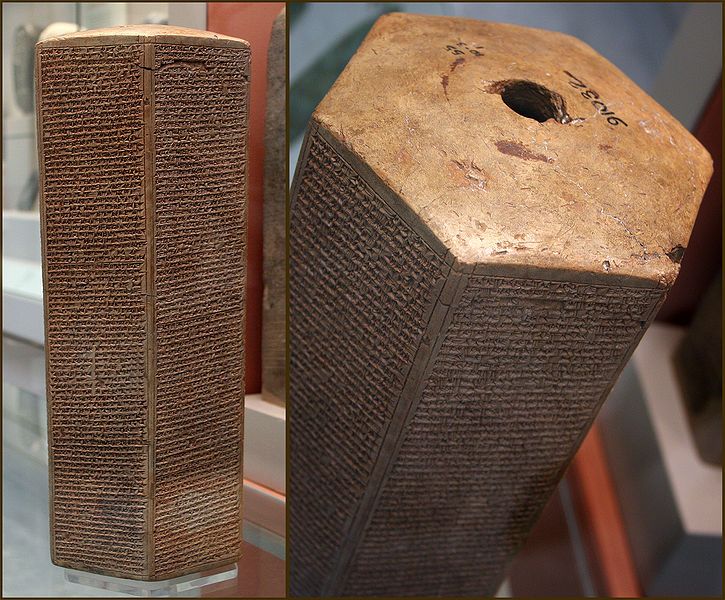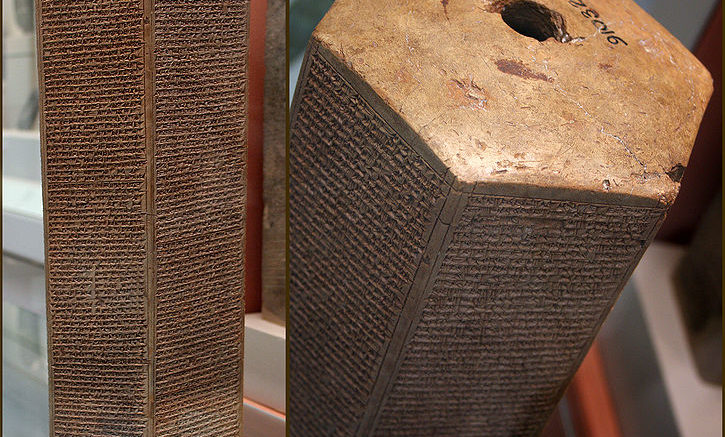One question often heard concerning creation and man’s origins, as well as life’s origins, is whether Biblical accounts describing man’s origins and God’s creation of the universe can be trusted. Are the Biblical accounts accurate? Did the creation really occur? Was there really an Adam? an Eve? Was there really a world-wide global flood? There is amazing evidence that many miraculous events described in the Bible actually took place as described by the Bible. In this article we shall look at some of this evidence.
 Clay prism describing Sennacherib’s siege on JerusalemDuring the time of King Hezekiah, mentioned in the Bible, the king of Assyria, Sennacherib, came against Hezekiah at Jerusalem. Sennacherib brought thousands of troops. One event described in the Bible is the destruction of 185,000 of these troops by a “blast” from heaven. Closely associated with this in time is the miraculous reversal of the sun’s motion as indicated on a sun dial. Rabbinical sources put this reversal of the sun on the evening of the destruction of Sennacherib’s army by the blast.1,2,3
Clay prism describing Sennacherib’s siege on JerusalemDuring the time of King Hezekiah, mentioned in the Bible, the king of Assyria, Sennacherib, came against Hezekiah at Jerusalem. Sennacherib brought thousands of troops. One event described in the Bible is the destruction of 185,000 of these troops by a “blast” from heaven. Closely associated with this in time is the miraculous reversal of the sun’s motion as indicated on a sun dial. Rabbinical sources put this reversal of the sun on the evening of the destruction of Sennacherib’s army by the blast.1,2,3
The event is recorded in several places in the Bible. For the full story, with some context, you can look at 2 Kings 18-19, 2 Chronicles 32, and Isaiah 37-38. I will briefly summarize the story below as found in the Bible.
Sennacherib, King of Assyria, threatened to come against King Hezekiah in Jerusalem. The prophet Isaiah told Hezekiah that the city would be protected, and as a sign of this protection (as well as a sign for the healing of Hezekiah), the shadow on a sun dial would move backwards. That same day (or night) there was a “blast” from heaven which destroyed 185,000 troops of Sennacherib. The rest of the army then left, including Sennacherib, who was slain later in his own land as Isaiah had prophesied. The most likely date for this is 687 BC – see section below, Rabbinical Sources, for the reason for this date. Note that Assyria had earlier come against Jerusalem in 721-722 BC, which ought not to be confused with the 687 BC invasion.
We see two miraculous events in this story:
- the destruction of 185,000 troops by a “blast” from heaven in a single night
- the reversal of a shadow on a sun dial
Now let us see if there is any evidence, other than the Biblical account, that these events occurred.
Rabbinical sources
The Talmud and Midrash claim a blast fell from the sky.4 They also can help pin down the time of these occurrences. There is some debate over whether there were one or two incursions against Jerusalem by King Sennacherib of Assyria (not including the 721/722 BC incursion). One article lists 2 possible dates for these campaigns.5 It gives 688-687 BC as the date of a second incursion, the one this article deals with. However, in the first incursion against Jerusalem, Hezekiah agrees to pay tribute. In the second incursion, instead of paying tribute, the Assyrian army is very much decimated.
Both dates are close to the time period supported by our extra-biblical sources. Either date would not invalidate much of the support from these sources that something unusual did happen around this time. However, some sources indicate that something unusual did happen in 687 BC, which is one of the possible dates for the siege of Jerusalem. With this support, the 687 BC date is more likely.
2 Kings 19:9 clinches this. This scripture mentions Tirhaka as the King of Ethiopia. But Tirhaka was not king of Ethiopia earlier at the time of the first possible time for the siege which is associated with the sun’s shadow moving backwards; he was king, however, in 687 BC. This indicates the events associated with Sennacherib’s siege of Jerusalem – the “blast” from heaven, the destruction of 185,000 troops, and the movement of the sun’s shadow backwards – could not have taken place in 701 BC; the remaining date is 688-687 BC. So, the Bible seems to be clear that there were two incursions by Sennacherib, not one.
Other sources support that there were two Assyrian campaigns of Sennacherib against Hezekiah, and also support the 687 BC date.6, 7
To further pin down the time of the destruction of the Assyrian army, we look to the Talmud and Midrash, which place the destruction of the Assyrian army on the first night of the Passover, when people began to sing the Hallel prayer.8,9,10,11, 12 This puts the time at near the vernal equinox, sometime in March-April, since this is when the Passover occurs. So we have a date of sometime from March to April of 687 BC.
Josephus
Flavius Josephus records that 185,000 troops of Assyria were destroyed in a single night.13 Josephus, quoting Berossus, says:
And Herodotus does indeed give us this history; nay, and Berosus, who wrote of the affairs of Chaldea, makes mention of this king Sennacherib, and that he ruled over the Assyrians, and that he made an expedition against all Asia and Egypt; and says thus: “Now when Sennacherib was returning from his Egyptian war to Jerusalem, he found his army under Rabshakeh his general in danger [by a plague], for God had sent a pestilential distemper upon his army; and on the very first night of the siege, a hundred fourscore and five thousand, with their captains and generals, were destroyed. So the king was in a great dread and in a terrible agony at this calamity; and being in great fear for his whole army, he fled with the rest of his forces to his own kingdom, and to his city Nineveh; and when he had abode there a little while, he was treacherously assaulted, and died by the hands of his elder sons, Adrammelech and Seraser, and was slain in his own temple, which was called Araske. Now these sons of his were driven away on account of the murder of their father by the citizens, and went into Armenia, while Assarachoddas took the kingdom of Sennacherib.” And this proved to be the conclusion of this Assyrian expedition against the people of Jerusalem.
Herodotus
The ancient Greek historian Herodotus also tells of the destruction, in a single night, of the army of Sennacherib. Herodotus saw an Egyptian statue of a god with a mouse in the god’s hand, which was placed to commemorate the destruction of the Assyrian army. Horus was perhaps this god. 14 The mouse was the sacred animal of the Egyptian city Letopolis. The name Letopolis has the same hieroglyph as a thunderbolt. There might be a connection with the thunderbolt and the blast from heaven which destroyed the Assyrian army. An Egyptian text from Letopolis describes a festival celebrating the “night of fire for the adversaries,” which fire was like “the flame before the wind to the end of heaven and the end of the earth.”15 The god with the mouse was a god of fire. Associated with this god is the following statement: “I come forth and go in the devouring fire on the day of the repelling of the adversaries.” Some have interpreted the mouse held in the palm of the statue of the god as symbolic of bubonic plague. It is interesting to note that Hezekiah became ill around the time of the blast from heaven and destruction of Sennacherib’s troops. Isaiah told him a reversal of the sun’s motion as shown in the sun dial would be a sign that he would recover from the illness. Rabbinical sources put the sign of the shadow reversal on the evening of the destruction of Sennacherib’s army by the blast.16,17,18
Chinese Records
Confucius
According to Edouard Biot, Chinese writings attributed to Confucius say that on March 23, 687 BC, there were no clouds but stars were not visible and, in the middle of the night, stars fell like rain. Please note that this time is precisely during the March-April time period during which rabbinical sources claim the destruction of the Assyrian army by the “blast” from heaven took place.
The Bamboo Books (ancient Chinese historical documents) also say that “stars fell like rain. The earth shook.”19
The Sun in China
Chinese records say something about unusual movements of the sun. Prince Tau of Yin was being held by the king of China when the sun moved backwards, which was taken as a sign to let Tau go home, according to Lu-Heng.20
A second century BC Chinese, Huai-nan-tse, says that during a battle, the sun went down, but then came back: “when the Duke of Lu-Yang was at war against Han, during the battle the sun went down. The Duke, swinging his spear, beckoned to the sun, whereupon the sun, for his sake, came back and passed through three solar mansions.”21
Note, that the time would be 3-6 hours later in China than it was in Jerusalem. So, if in Jerusalem the sun was visible (it was day), in China, where the time was several hours later, the sun might have already set, which would be consistent with the description from the Chinese accounts.
Ovid
As further evidence supporting the Biblical account of the reversal of the sun’s shadow, Ovid says that Phoebus, god of the sun, turned around:
“wresting his car about turned round his steeds to face the dawn.”22
This is also referred to by Ovid in Tristia:
“the horses of the sun turning aside.”23
Apollodorus
According to Apollodorus,
“Atreus stipulated with Thyestes that Atreus should be king if the sun should go backward; and when Thyestes agreed, the sun set in the east.”24
According to Velikovsky:
“Thyestes and his brother Atreus … living in the eighth century, … must have witnessed [the events] of the days of Isaiah. Greek tradition persists that a cosmic catastrophe occurred during the time of these tyrants: the sun changed its course…” 25
We could claim the stories of the ancients were merely myths, not history, but we would be remiss to not point out the mythical nature of Homer’s Iliad and Odyssey, with their cyclops and other unbelievable monsters and gods; however, the city of Troy, also mentioned by Homer, and once thought to exist only in myth, was actually found.
There is often a mixture of history with the mythological element in the ancient writings. In fact, one ancient writer himself, Euhemerus, pointed this out and claimed it to be true, especially of ancient Greek authors. Euhemerus claimed the Greek gods were exaggerated and distorted versions of real historical people.26
Other Unusual Events Near the Time of Sennacherib’s Siege on Jerusalem
If there was some astronomical event that affected the movements of the earth (or apparent movements of the sun), then this obviously would have been noticed in other parts of the world; it would have affected the entire planet. There are some very interesting observations that can be made, related to the sky, which happened near the time of the destruction of Sennacherib’s army.
This change in the sun’s movements hint at possible alterations in calendars. In fact, there was a change in many calendars shortly following this time, as though, perhaps, something strange had indeed occurred. We are not stating precisely what occurred, for we have limited information. We can see, however, that the movement of the shadow on a sun dial in a reverse direction would indicate major changes in the heavens, sky, and/or motion of the earth. One obvious concomitant of such change of the earth’s motion could easily be a corresponding change in the calendar, which is, after all, determined by the motion of the earth around the sun.
So let’s look at the calendar. The following pieces of evidence all pertain to the calendar, and for the most part, all seem to be clustered around or shortly after 687 BC. One thing to note is that if there were changes in the seasons, or if the calendar somehow was off by a day or two, it would not be noticeable for several years. Each year, the error of that year would be added to the errors of all the preceding years, until, finally, after accumulating for many years, we might find ourselves celebrating Christmas in the middle of warm summer weather!
So it should not be surprising that some calendrical changes might be implemented years after the events that changed the calendar actually occurred; in fact, this is what we should expect.
Calendar-Astronomical Changes
Strong indications that something unusual indeed did happen in the heavens around 687 BC will be given below. Also, the indication is that this change in the heavens was real, for any change in the heavens, for example, of the the length of a day or other time period, would be noticeable world-wide.
No New Year for 20 Years!
Babylon had no New Year festival for about 20 years, after 687 BC.27 Why would there be no New Year, beginning the year of the sun’s moving backwards?
Altering Israel’s Calendar
The Talmud says that Hezekiah, who ruled during this time around 687 BC, doubled the month of Nisan.28,29,30 Again, why at this time would there be a change in the calendar? The time of this calendar change is very near the time of the “blast” from heaven and the reversal of the sun’s shadow; the implication is that there was some astronomical event that was real enough to impact the calendar.
Reworking Assyrian Astronomy
Astronomical events, such as movements of planets and precession of equinoxes, were recalculated in the days of Assurbanipal, grandson of Sennacherib.31 If there were indeed changes in the heavens, then calendars might need to be recalculated.
Autumnal Equinox Altered by 9 Days – Israel & Babylon
Both Israel and Babylon made a 9-day change of the autumnal equinox.32
Another 9-Day Difference – Nineveh
Clay tablets from Nineveh (the home of Sennacherib) gave two different dates for a vernal equinox; the difference between the two dates was 9 days. 33
A Statement from Daniel
Daniel said God changed times and seasons: “And he changeth the times and the seasons:…” Dan 2:21
India’s Calendar
Calendar changes were made in India around the same time.34
China’s Calendar
Calendar changes were also made in China around this time.35
Egypt’s Calendar
A new calendar was started in Egypt by Osorkon, the high priest in year 15 of the reign of Sosenk III. This was about the time of Sennacherib’s assault on Jerusalem; the exact time for events in Egypt has been debated,36 and arguments that accepted dates of events in Egypt may be off have been given in Pharaohs and Kings by David Rohl.37
Rome’s Calendar
Around this time in Rome, the calendar was reformed by Numa.38,39 We know this is near the time of the reversal of the shadow, since He was a contemporary of Hezekiah.40
Solon’s Calendar
Solon adjusted the calendar around this time, according to Diogenes Laertius and Plutarch.41
Thales’ Calendar
Thales of Milesia, born in 640 BC, apparently predicted an eclipse and adjusted the calendar.42
Japan’s Calendar
In Japan, in 660 BC, a calendar was introduced.43 This is 27 years after 687 BC; the list of emperors starts at this time, 660 BC.44
China’s Eclipses
In China, around this time, astronomer Y-hang told the emperor Hiuen-tsong that prediction of eclipses was no longer possible due to changes in the sky.45
Summary and Conclusion
We have agreement on the date of certain events mentioned in the Bible from Confucius and the Bible and rabbinical sources. These events were a “blast” from heaven, the resulting destruction of 185,000 Assyrian troops, and the reversal of the sun’s shadow. That there was some change in the heavens near this time is strongly indicated by the reworking of calendars world-wide and the failure around this time of normal astronomical predictions. Chinese sources also claim the sun reversed its path, and the time difference (sunset versus day) between the Biblical and the Chinese accounts, rather than contradicting the Biblical account of the sun’s shadow reversing, gives support that the event in the Bible did occur since the sun would be further along its course in China than in Jerusalem. We cannot therefore say these events described in the Bible were impossible due to contradiction of history; to the contrary, we see history provides evidence consistent with the Biblical account.
TASC’s mission is to rebuild and strengthen the foundation of the Christian faith by increasing awareness of the scientific evidence supporting the literal Biblical account of creation and refuting evolution.
- 1. Johnson K (2006) 23, Ancient Seder Olam: A Christian Translation of the 2000-year-old Scroll, CreateSpace Independent Publishing Platform
- 2. Eusebius (translated by Armstrong JJ) (2013) Commentary on Isaiah, IVP Academic
- 3. Ginzberg L (2001) The Legends of the Jews — Volume 4, < http://www.gutenberg.org/ebooks/2882 > Accessed 2012 Nov
- 4. Ginzberg L (2001) The Legends of the Jews — Volume 4, < http://www.gutenberg.org/ebooks/2882 > Accessed 2012 Nov
- 5. Bratcher D, Old Testament History, Assyrian Dominance (745 BC-640 BC), < http://www.cresourcei.org/othassyrian.html > Accessed 2012 Nov
- 6. Albright (1956) Bulletin of the American Schools of Oriental Research (141) 23-26
- 7. Bright J (1962) Excursus I, “The Problem of Sennacherib’s Campaigns to Palestine”. A History of Israel, Westminster John Knox Press, 296-308
- 8. Steinsaltz A (2010) The Koren Talmud Bavli: Tractate Pesahim, Koren Publishers, Jerusalem
- 9. Johnson K (2006) 23, Ancient Seder Olam: A Christian Translation of the 2000-year-old Scroll, CreateSpace Independent Publishing Platform
- 10. Neusner J (2002) The Tosefta: Translated from the Hebrew, with a New Introduction, Hendrickson Publishers, P.O. Box 3473, Peabody, Massachusetts 01961-3473
- 11. Freedman H (1992) Midrash Rabba, III Soncino Pr Ltd
- 12. Ginzberg L (2001) Chapter IX. THE LATER KINGS OF JUDAH, The Legends of the Jews — Volume 4, < http://www.gutenberg.org/ebooks/2882 > Accessed 2012 Nov
- 13. Josephus F (translated by Whiston W) (1981) Book X, Chapter 1, Section 4-5, Antiquities of the Jews, Josephus: Complete Works, Kregel Publications, Grand Rapids, MI 49501
- 14. Egyptian Mythology < http://realhistoryww.com/world_history/ancient/Misc/Egypt/Egyptian_Mytho… > Accessed 2012 Nov
- 15. Wainwright GA (1932) Letopolis, Journal of Egyptian Archaeology <b>XVIII</b>
- 16. Johnson K (2006) 23, Ancient Seder Olam: A Christian Translation of the 2000-year-old Scroll, CreateSpace Independent Publishing Platform
- 17. Eusebius (translated by Armstrong JJ) (2013) Commentary on Isaiah, IVP Academic
- 18. Ginzberg L (2001) The Legends of the Jews — Volume 4, < http://www.gutenberg.org/ebooks/2882 > Accessed 2012 Nov
- 19. Legge J (1970) The Chinese Classics with a Translation, Critical and Exegetical Notes, Prolegomena, and Copious Indexes [Vols. I-V], Hong Kong University Press, Vol III, Part 1, 125
- 20. Forke A (1975) The World-conception of the Chinese: Their Astronomical, Cosmological and Physico-philosophical Speculations, Arno Press, 87
- 21. Forke A (1975) The World-conception of the Chinese: Their Astronomical, Cosmological and Physico-philosophical Speculations, Arno Press, 86
- 22. Ovid (translated by Mozley JH) (1929) The Art of Love and Other Poems, Loeb Classical Library, 328 ff.
- 23. Ovid (translated by Wheeler AL) (1924) Tristia, Harvard University Press, 391 ff.
- 24. Apollodorus (translated by Frazier JG) (1921) The Library, Vol. 2, Loeb Classical Library
- 25. Velikovsky I (1950) Worlds in Collision, Doubleday, 223-224
- 26. Spears J (2008 Apr 1) Noah and Family: Myth, Legends, Ancient History and the Bible < http://tasc-creationscience.org/content/noah-and-family-myth-legends-anc… > Accessed 2012 Nov
- 27. Smith S (1924) Babylonian Historical Texts Relating to the Capture and Downfall of Babylon, Methuen, London, 22, 25
- 28. Babylonian Talmud: Tractate Berakoth. Berakoth 10b < http://www.come-and-hear.com/berakoth/berakoth_10.html > Accessed 2012 Dec
- 29. Point by Point Outline. Pesachim 56 < http://www.dafyomi.co.il/pesachim/points/ps-ps-056.htm > Accessed 2012 Dec
- 30. Ginzberg L (2001) The Legends of the Jews — Volume 4, < http://www.gutenberg.org/ebooks/2882 > Accessed 2012 Nov
- 31. Velikovsky I (1950) Worlds in Collision, Doubleday, 353
- 32. Velikovsky I (1950) Worlds in Collision, Doubleday, 354-355
- 33. Velikovsky I (1950) Worlds in Collision, Doubleday, 350
- 34. Mar AD (1900) The Worship of Augustus Caesar, Derived from a Study of Coins, Monuments, Calendars, Aeras and Astronomical and Astrological Cycles, the Whole Establishing A New Chronology and Survey of History and Religion, Cambridge Encyclopedia Co., 62 Reade St., NY
- 35. Mar AD (1900) The Worship of Augustus Caesar, Derived from a Study of Coins, Monuments, Calendars, Aeras and Astronomical and Astrological Cycles, the Whole Establishing A New Chronology and Survey of History and Religion, Cambridge Encyclopedia Co., 62 Reade St., NY
- 36. The 22nd Dynasty and its Connections < http://www.specialtyinterests.net/dyn22.html > Accessed 2012 Dec
- 37. Rohl D (1995) Pharaohs and Kings, Crown Publishers, Inc. New York, NY
- 38. Plutarch (translated by Perrin B) (1914) Lives, I, Theseus and Romulus. Lycurgus and Numa. Solon and Publicola, Loeb Classical Library
- 39. Plutarch (1914) Plutarch’s Lives with an English Translation by Bernadotte Perrin in Eleven Volumes, I, Theseus and Romulus, Lycurgus and Numa, Solon and Publicola < http://archive.org/details/plutarchslives01plut2 > Accessed 2012 Dec
- 40. Augustine, Chapter 27. The City of God, Book 18, < http://etext.lib.virginia.edu/etcbin/toccer-new2?id=AugCity.xml&images=i… > Electronic Text Center, University of Virginia Library, Accessed 2012 Nov
- 41. Velikovsky I (1950) Worlds in Collision, Doubleday, 359
- 42. Thales < https://en.wikipedia.org/wiki/Thales > Accessed 2012 Dec
- 43. Velikovsky I (1950) Worlds in Collision, Doubleday, 360
- 44. List of Emperors of Japan < http://en.wikipedia.org/wiki/List_of_Emperors_of_Japan > Accessed 2012 Dec
- 45. Velikovsky I (1950) Worlds in Collision, Doubleday, 360





